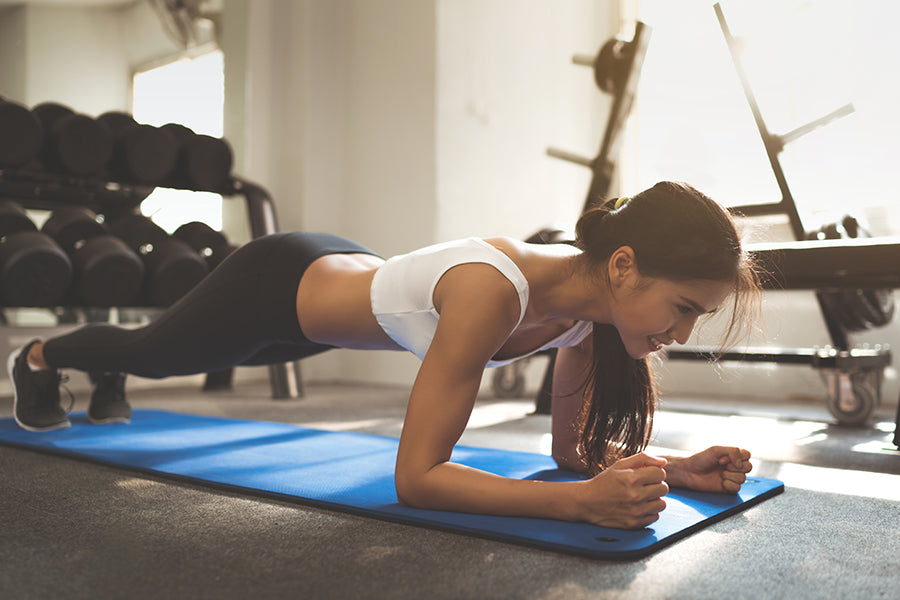When it comes to full-body exercises, planks are a powerhouse move as they help tone your entire body. Planks also offer physical benefits—they can help strengthen and stabilize your core muscles while improving posture and balance.
Additionally, planks are incredibly versatile; whether you choose the traditional version or mix it up with variations, this exercise is perfect for working out at home or in the gym.
In this blog post, we'll dive into how to properly do a plank (including different types of planks), the primary benefits you should be aware of when performing these exercises regularly, and which major muscle groups you'll be targeting during each plank session.
Related Article: Bear Planks: How to Do With Proper Form, Benefits, Variations, and More
Planks & Their Benefits
A plank is a popular exercise used to improve core strength and stability. When done correctly, it targets multiple muscle groups, including abdominals, glutes, shoulders, back, and chest muscles. The goal of the plank is to maintain a static posture for a certain amount of time.
To do this properly, you must engage your core throughout the exercise and ensure that your body is aligned properly from head to toe. There are multiple variations of planks that can be added to your regimen to help you challenge yourself and increase the difficulty simultaneously.
What makes planks such an effective exercise is the ability for anyone to do them with little or no equipment required. Plank can be incredibly beneficial for those looking to improve their physical fitness, as it has various benefits, such as:
Improve Posture
One of the benefits of doing planks is that they can help improve your posture. Good posture is important for both your physical and mental health. By strengthening the muscles in your core, planks improve your posture and reduce the risk of injuries and similar issues.
Relieve Back Pain
Another benefit of planks is that they can help relieve back pain. Back pain is a common problem caused by various factors, including poor posture, muscle imbalances, and weak core muscles.
Planks can help strengthen the muscles in your core and improve your posture, which can, in turn, help reduce or eliminate back pain.
Related Article: Exercises to Ease Your Back Pain, Restore Your Health
Improve Balance & Stability
Planks can also help improve your balance and stability. It is crucial as you age, as balance and stability problems can lead to falls and injuries. By strengthening the muscles in your core, planks can help you maintain your balance and stability even as you age.
Increase Flexibility
In addition to all of the other benefits, another great benefit of planks is that they can help to increase your flexibility. It is because plank exercises stretch the muscles in your body, including your hamstrings, chest, and shoulders.
Increased flexibility can improve performance in other exercises, such as squats and lunges, and reduce the risk of injuries.
What Muscles Do Planks Work?
Planks are a great way to work the entire core area and build strength. The primary muscles worked during a plank exercise include the transverse abdominis, rectus abdominis, erector spinae, obliques, glutes, and shoulders.
The transverse abdominis is the muscle that wraps around like a corset to create stability in the core area. The rectus abdominis is responsible for creating the 'six-pack' look. The erector spinae muscles run along both sides of the spine and extend from the neck down to the lower back.
The obliques are located on both sides of your abdomen and help create trunk rotation while stabilizing it. Your glutes provide extra stability when doing any core exercise; in planks, they assist with keeping your body held up off the floor.
Lastly, your shoulders are engaged—mainly when you do side planks—to keep you lifted off the ground evenly on both sides. Planks target many muscle groups at once, making them an effective exercise for developing core strength!
Planks Variations
There are several variations of planks to help you target different muscles. Some common variations are:
Standard Plank

The standard plank is the most common variation of the exercise and is performed by assuming a push-up position with your hands placed shoulder-width apart and your feet hip-width apart. You simply hold the position for the desired amount of time.
Forearm Plank

The forearm plank is performed the same way as the standard plank, but with your forearms resting on the ground instead of your hands. This variation is often used by people new to the exercise, as it is less challenging than the standard plank.
Side Plank

The side plank is performed by lying on your side with your feet stacked on each other and your elbow directly below your shoulder. From there, you raise your hips off the ground and hold the position for the desired amount of time.
Up and Down Plank

The up and down plank is a more advanced exercise variation that challenges balance and coordination. To perform the up and down plank, start in a standard plank position with your hands placed shoulder-width apart and your feet hip-width apart. From there, you will drop one arm to your forearm and then the next. Reverse the motion to return to the starting position.
One-Arm Plank

The one-arm plank is another advanced exercise variation that challenges balance and coordination. To perform the one-arm plank, start in a standard plank position with your right hand placed shoulder-width apart and your feet hip-width apart.
From there, lift your left hand off the ground and reach it forward until it is in line with your right hand. Hold this position for the desired time before repeating it on the other side.
Mistakes to Avoid
Common mistakes include maintaining improper form, not correctly engaging the core and neck muscles, and holding for too long. It is essential to keep alignment throughout your body when planking by engaging your core, keeping a neutral head and spine position, and ensuring that you are balanced from head to toe.
Additionally, many people tend to hold the position for too long or rapidly switch from one type of plank to another without rest or refocus, which can cause fatigue and decrease performance.
Taking a plank break between sets will help avoid over-planking risks. With practice and proper technique, you'll be able to do longer planks with better form in no time.
Knowing basic safety guidelines and precautions can help you experience the benefits of planking without any unwelcome injuries. When performing a plank, always engage the core muscles of your abdomen. If you experience lower back pain during this exercise, your form likely needs some adjustment.
Additionally, it is essential to take rests as needed and not to push yourself beyond what your body can handle; if your arms or legs begin shaking, you should stop immediately and work on doing shorter sets at a lower intensity.
Last but not least, remember that an appropriate warm-up of 5 minutes should precede any intense physical activity – this will help your body prepare for the exercise and reduce the likelihood of injury.
The Bottom Line
Now that you understand how to do a plank and the benefits of adding this exercise to your routine give it a try! Start holding the position for 20-30 seconds and gradually increase the time as you get stronger. Remember to keep your form in check, engaging your core, keeping your back straight, and avoiding rocking side to side or letting your hips sag.
Add planks into your regular workout routine 2-3 times per week for best results. Soon you'll see changes in your posture, strength, and stability! Don't forget to challenge yourself by trying variations like a forearm or one-arm plank once you've mastered the basic plank.











